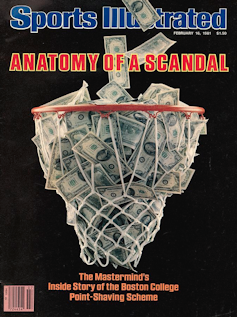A few days before Christmas, I went to see the NHL’s Nashville Predators play on home ice against the defending Stanley Cup champion Colorado Avalanche.
Amidst all the craziness of a modern pro sports experience – the home team skating from a giant saber-toothed tiger head, the mistletoe kiss cam, a small rock band playing the seasonal hits between seasons – there is a constant advertisement for DraftKings, a company known as a sportsbook that bets on athletic events and pays out the winnings.
Its name flashed brightly on the Jumbotron above center ice as the starting lineups were announced. Its logo reappeared when the crew hurriedly cleared the ice during timeouts. “DraftKings Sportsbook” is not only on the yellow jackets worn by the people shoveling the ice shavings, it is also on the carts they use to collect the ice.
All of this comes a few days after the Predators announced a multiyear partnership with another sportsbook, BetMGM, which will include not only signage at their home venue, Bridgestone Arena, but also a BetMGM restaurant and bar.
If I was nursing that night, I could go to the sports betting app on my smartphone and place a bet on the game. Tennessee is one of 33 states and the District of Columbia where sports betting is legal. On January 31, 2023, Massachusetts became the latest state to legalize the practice.
The point to describe the whole scene is simply this: In the nearly five years since the Supreme Court allowed states to legalize sports betting, an entire industry has grown up that, for tens of millions fans all over the country, now part of the show.
The seamless integration of American sports betting – impossible to ignore even for non-betting fans – represents a remarkable transition for an activity that was banned in most of the country just a few years ago.
A new world of sports
Let’s look at the numbers for starters.
Since May 2018, when the US Supreme Court overturned a law limiting sports betting in four states including Nevada, US $180.2 billion has been legally bet on sports, according to research by the American Gaming Association. That generated $13.7 billion in revenue for sportsbooks, according to figures provided to me by the AGA, the industry research and lobby group.
Before the NFL started in September, the AGA reported that 18% of American adults – more than 46 million people – planned to bet this season. Much of that is likely to be wagered through legal channels, as opposed to so-called corner bookies, or illegal operatives.
So, who bets on sports? In an interview, David Forman, the AGA’s vice president for research, told me that compared to traditional gamblers — those who might play slots, for example — “sports bettors are a different demographic. They’re younger. they, they are more men, they also earn more.”
They are people like Christian Santosuosso, a 26-year-old creative marketing professional who lives in Brooklyn, New York. Santosuosso did not bet on the games until it became legal. Now he and his friends pool their money on an NFL Sunday to add interest to a game and the conversation in the room.
“It’s fun,” he told me in a phone interview. He explained that even a hard gambling loss can be fun or funny, a way to remember the mistakes your team made that affected whether you won the bet. But he added that he has a limit on how much he can bet.
Coverage and conversation
Shortly after the Supreme Court decision in 2018, I wrote a piece for The Conversation asking if the media should start producing content aimed at bettors.
The answer is a clear “yes” – and it seems to have helped change the way sports betting is discussed.
As I write this, when I look at the front page of ESPN.com, I see that the University of Georgia is a 13.5-point favorite over Texas Christian University in the college football national championship. It’s front and center, right next to the kickoff time and the TV network where it airs.
But that’s the least of it.
ESPN has broadcast a game show since 2019, “Daily Wager.” In September 2022, the sports conglomerate announced a range of new content centered around betting tips and selections. And SportsCenter anchor Scott Van Pelt is famous for his “Bad Beats” segment, in which Van Pelt usually highlights how a team’s winning side of the point spread goes down at the last second on a crazy that way.
Meanwhile, a cottage industry of betting tip channels has sprung up on YouTube – if you type “#sportsbetting” into YouTube’s search bar, you’ll find thousands of them.
Another example of how things have changed: On Jan. 2, 2023, the University of Utah football team had the ball and goal with 43 seconds left, down 21 points to Penn State in the Rose Bowl. The game is essentially over. However, commentators have noted that a touchdown means more to some people.
WHO? Why? The announcers did not elaborate, but the implication was clear: Those who bet the excess – who bet that both teams will score more than 54 points – have a lot riding on that touchdown. So, in a sense, is ESPN. In a blowout, fans of both teams tend to tune out. But when there’s money riding on something like surplus, eyes stay glued to the screen.
Utah scored on third down with 25 seconds left. Final score: Penn State 35, Utah 21.
The danger and the ceiling
I’ve been editing sports articles since the early 1990s and running Penn State’s sports journalism program since 2013. I’ve noticed how my students now often talk about the point spread — the expected margin of victory – and even the excess below. , a bet on the total number of points scored.
That didn’t happen often when I first went to State College, nor in the newsroom before that.

Illustrated in Sports
Sports leagues used to strongly oppose gambling. And while they’re still worried about keeping players from betting, many leagues — especially the NFL — have done a complete U-turn since legalization.
There are many reasons for this change of heart. While the concern was once about losing the integrity of the game in a betting scandal, now sports leagues can argue that legal betting allows for better monitoring of potential cheating. If heavy betting occurs on a team, or if there is a sudden change in betting patterns, this will all show up in sportsbooks and may indicate nefarious activity.
There’s also significant fan interest in legal betting – 56% of American adults, and nearly 7 in 10 men, recently told Pew they’ve read at least a little about how widespread legal betting is. sports.
And, of course, there is a lot of money from a new group of sponsorships – the sportsbooks – that helped push the NFL’s total sponsorship revenue to a record $1.8 billion in the 2021 season.
The danger, of course, is gambling addiction.
And while the AGA quickly noted that its member companies promised to provide information about problem gambling to their customers, legalization undoubtedly provided easier and safer access to sports betting.
Keith Whyte, executive director of the National Council on Problem Gambling, said in a telephone interview that his group’s research found that nearly 25% of American adults bet on sports, slightly more than the AGA’s estimate. That percentage jumped from roughly 15% before the Supreme Court decision, according to NCPG.
While that’s a big increase, it also suggests there may be a ceiling coming — that is, if all the states that do so legalize sports betting, betting still won’t be possible in many states. people than today, Whyte speculated. .
“I think this has changed the market in many ways,” said Whyte, “but my guess is primarily to increase the intensity – and associated risk of problem gambling – among fans who have become fans.”
